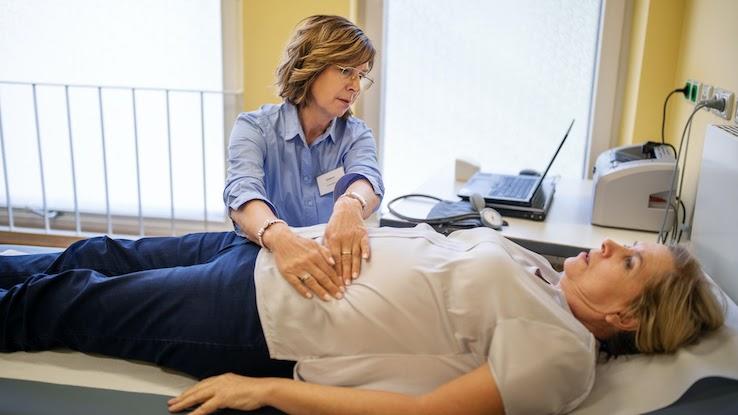Cervical Cancer: Understanding Causes, Symptoms, Treatments and More

Cervical cancer occurs when cells of the entrance to a person’s uterus divide and grow faster than normal. It is the fourth most common cancer in people assigned female at birth and causes approximately 311,000 deaths per year worldwide. Almost all cases of cervical cancer are linked to the presence of a high-risk type of a virus known as human papilloma virus (HPV), which is detected on a routine pap smear test.
When cervical cancer is detected early, it is one of the most treatable cancers. And the HPV vaccine can prevent this cancer before it starts. Learn more about cervical cancer and how to protect yourself.
What Is Cervical Cancer?

The cervix is located at the entrance to the uterus and separates the vagina from the uterus. There are two broad types of cells within the cervix: glandular cells and squamous cells. Glandular cells are present mostly inside the cervical canal, which is the opening to the uterus. Squamous cells are present on the outside of the cervix, are in direct contact with the vagina and are the cells that a doctor or nurse can see during examination with a speculum. Cancers tend to develop at the joining point of these two types of cells, which is known as the transformation zone.
Cervical cancer is generally a slow-growing cancer, and doctors usually detect it in the early stages through routine pap tests. In addition, medical professionals can often detect precancerous cells and provide treatment before the cancer even fully develops.
There are three types of cervical cancer:
- Squamous cell carcinoma: Most cancers (90%) are classified as squamous cell carcinomas. This type of cancer starts in the squamous cells, which are located in the part of the cervix closest to the vagina that’s known as the ectocervix.
- Adenocarcinoma: Some remaining cervical cancers are classified as adenocarcinomas. This type of cancer forms in the part of the cervix closest to the body of the uterus, which is known as the endocervix. This is where mucus-producing glandular cells reside.
- Adenosquamous carcinoma: This type of cancer involves both squamous and glandular cells.
Common Symptoms
Cervical cancer in its earliest stage may not produce any symptoms. As the disease progresses, symptoms may begin to appear, indicating a more advanced form of cervical cancer. Symptoms may include vaginal bleeding, particularly after intercourse or between periods; a change in vaginal discharge, with the substance possibly having a foul odor or containing blood; and general pelvic pain or pain during sex. Make an appointment with your doctor right away if you’re experiencing any of these signs or symptoms to rule out cervical cancer.
Cervical cancer used to be the leading cause of death for people assigned female at birth in the United States. However, thanks to the introduction of regular screening via pap tests, the number of deaths due to this condition has reduced significantly. Routine pap tests take a small sample of the cells in your cervix. These cells are analyzed in a laboratory to check if there are any abnormalities present. If the test detects abnormal cells, your doctor will likely begin treating them right away. Your doctor might also recommend you be tested for HPV, as HPV is the leading cause of cervical cancer.
If the test reveals you have abnormal cervical cells, you may be referred to undergo further testing. This may involve:
- Colposcopy: This is performed by a gynecologist and involves examination of the cells of your cervix using a special tool called a colposcope.
- Biopsy: Your doctor will retrieve a small sample of the cells within your cervix using special tools and have the sample sent out to the laboratory for further testing. This may be done in conjunction with a colposcopy.
- Conization: During this procedure your doctor will remove a cone-shaped segment of cells from your cervix for examination under a microscope. Using a cone-shaped sample allows the lab to test deeper layers of the tissues in your cervix.
If further testing discovers precancerous cells, sometimes referred to as cervical intraepithelial neoplasia (CIN), you’ll be scheduled for treatment of these cells to prevent them from developing into cancer.
Diagnosing Cervical Cancer

The diagnosis of cervical cancer is based on the laboratory findings indicated in the cells taken from your cervix. Once your doctor diagnoses cervical cancer, you’ll need to undergo other tests to determine whether the cancer has spread to other areas of your body. These other tests might involve:
- Ultrasound scan
- Computed tomography (CT) scan
- Magnetic resonance imaging (MRI) scan
- Positive emission tomography (PET) scan
- Lymph node biopsy in which a doctor takes a sample of some of the cells within a lymph gland to see if the cancer has spread there
After further testing, your doctor can determine which type of cancer you have, along with its stage. Stages range from 1 to 4 and indicate how severe the cancer is and how far it has spread.
- Stage 1: The cancer cells have not spread beyond your cervix.
- Stage 2: The cancer has begun to spread from your cervix to your uterus but has not reached your pelvic wall or the bottom portion of your vagina.
- Stage 3: The cancer has progressed from your cervix and uterus to your pelvic wall or the lower part of your vagina.
- Stage 4: The cancer has spread to nearby organs or other parts of your body.
Almost all cervical cancers can be attributed to the presence of a high-risk strain of HPV. This common virus is thought to alter some of the genes in our bodies. This causes cervical cells to grow uncontrollably, which can turn into cancer in some people.
There are other factors that increase your risk of developing cervical cancer, including:
- Having HIV or other sexually transmitted diseases
- Smoking
- Drinking excessive amounts of alcohol
- Having a genetic predisposition or a family history of cervical cancer
- Taking oral contraceptive pills
- Having a poor diet
You can help prevent cervical cancer by getting the HPV vaccine. The vaccine also protects against other cancers HPV can cause, such as rectal and throat cancers. The CDC recommends that all preteens get the vaccine at age 11 or 12 — but everyone ages nine to 45 can get this vaccine. If you haven’t gotten the vaccine yet and you’re in this age range, talk with your doctor about the HPV vaccine.
Treatments for Cervical Cancer

The treatment you receive for your condition depends on several factors, including the stage of the cancer, the presence of any underlying health conditions and your personal preference. Treatment options may include:
- Surgery: During a surgical procedure the surgeon will remove the cancerous cells or tissue from your cervix. Surgery may include a partial or radical hysterectomy, in which doctors remove your cervix or uterus and possibly part of your vagina and surrounding lymph nodes, depending on how advanced the cancer is and whether or not it has spread beyond your cervix.
- Chemotherapy: Chemotherapy uses drugs to reduce or stop the growth of the cancer cells.
- Radiation: This is the use of high-energy rays, like powerful X-rays, to kill cancer cells. The radiation is targeted only to the area of your body where the cancer is present. Radiation is sometimes used in conjunction with chemotherapy for optimum results, especially in advanced cases.
The use of complementary treatments such as acupuncture, herbal supplements and a balanced diet and nutrition program may be helpful for patients with cervical cancer — or cancer of any kind. While you should never use these integrative and complementary medicines in place of traditional medical practices, certain techniques may be helpful in relieving some symptoms associated with cervical cancer or cancer treatments. This type of medicine can help to improve your quality of life.
People who have their symptoms diagnosed during the early stages have an excellent prognosis. With the use of routine pap tests and HPV tests, your doctor will conduct regular screenings to detect the presence of precancerous cells within your cervix. Cervical cancer that’s diagnosed and treated in the early stages, before it’s spread to other areas of your body or nearby tissue, has the most positive outcome. Once cancer has spread to other locations and to prominent body organs, the chance of entirely eliminating the cancer decreases.
If you’re worried about any symptoms that may be the result of cervical cancer, you should speak with your healthcare provider right away. It’s also important to attend regular screening appointments to make sure your cervix is healthy and to detect any abnormal cells at a very early stage.
Dr. Samantha Miller, MBChB
Resource Links:
https://www.who.int/health-topics/cervical-cancer
https://www.cancer.org/cancer/cervical-cancer/about/what-is-cervical-cancer.html
https://www.nhs.uk/conditions/cervical-cancer/
https://www.cdc.gov/cancer/cervical/statistics/
https://www.cancer.gov/types/cervical
https://medlineplus.gov/cervicalcancer.html
https://bestpractice.bmj.com/patient-leaflets/en-gb/pdf/3000145/Cervical%20cancer.pdf





